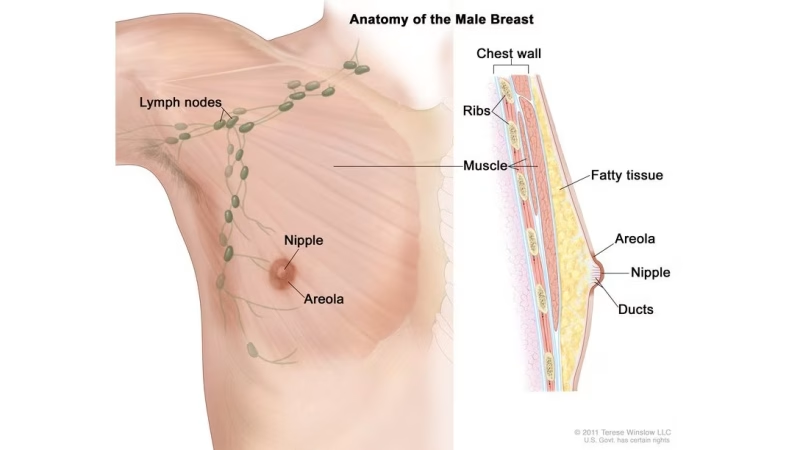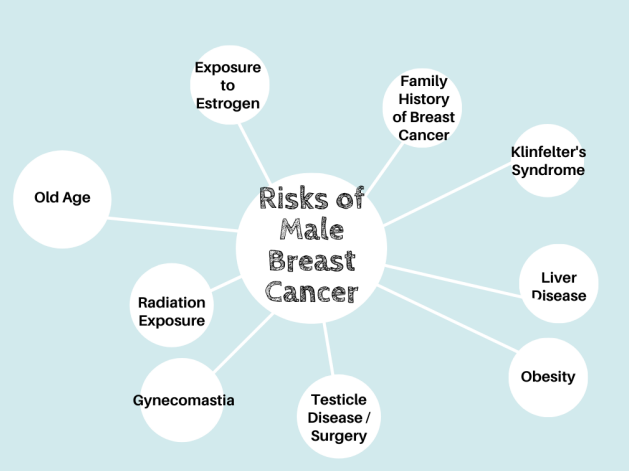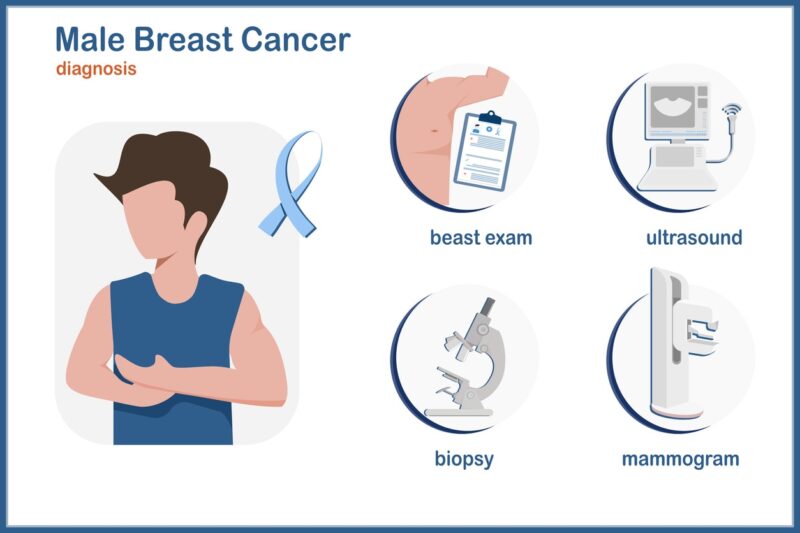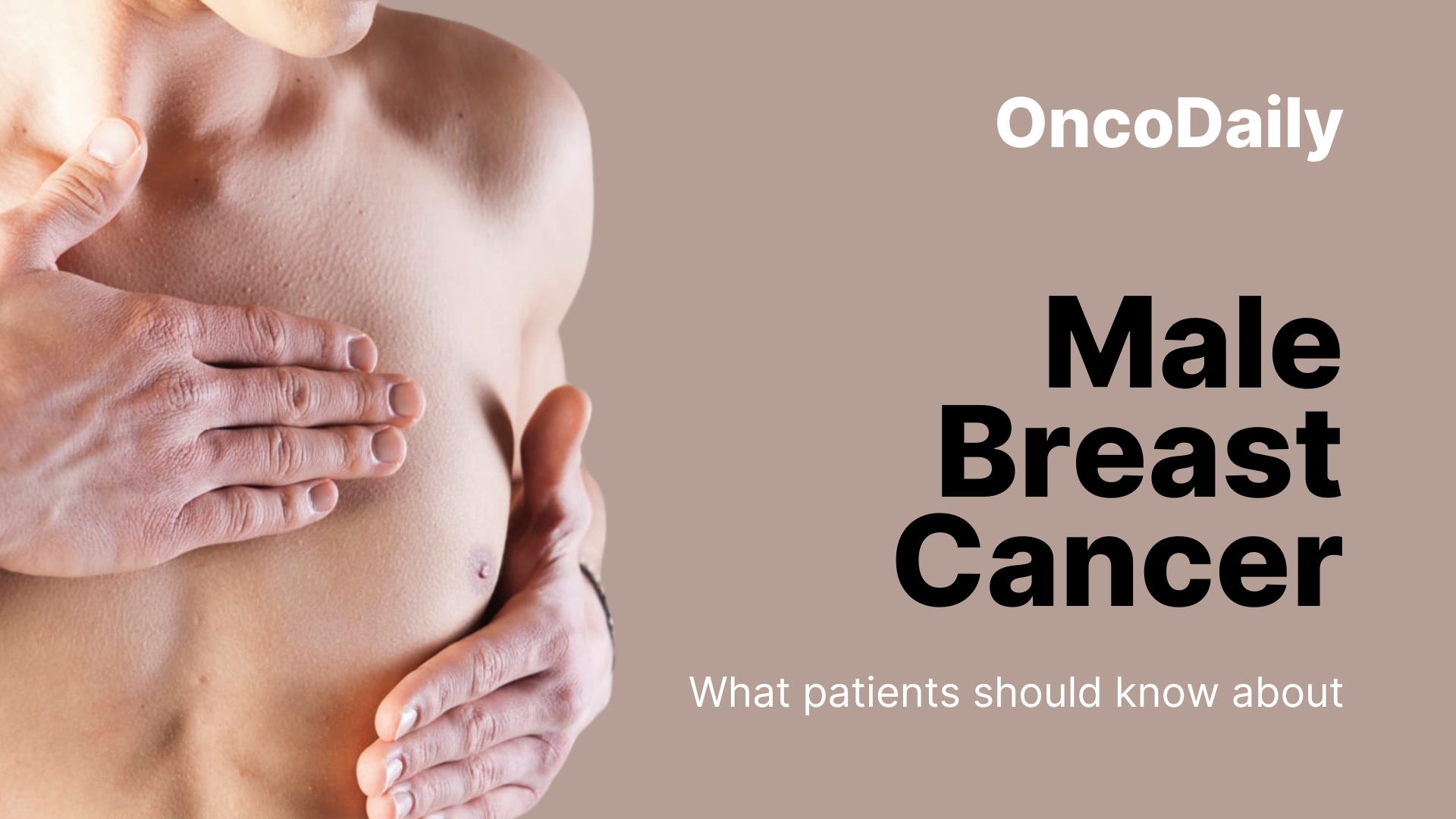What is Male breast cancer ?
Male breast cancer is a rare type of cancer that forms in the breast tissue of men. Although breast cancer is much more common in women, men also have breast tissue, which means they can develop cancer in the same way. However, because many people don’t realize that men can get breast cancer, it is often diagnosed at a later stage, making early detection very important.Male breast cancer usually begins in the milk ducts (ductal carcinoma), but it can also develop in the lobules (lobular carcinoma) or other parts of the breast.
While male breast cancer is rare, it is treatable, especially when found early. Knowing the symptoms, risk factors, and treatment options can help men take control of their health and seek care if needed.

How Common Is It?
According to the American Cancer Society’s Cancer Facts & Figures 2025, about 2,800 new cases of invasive breast cancer are expected to be diagnosed in men in the United States this year, accounting for less than 1% of all breast cancer cases. Approximately 510 men are projected to die from the disease. The lifetime risk of a man developing breast cancer is about 1 in 1,000.
How Does It Differ from Breast Cancer in Women?
Although breast cancer in men and women is similar, there are some key differences in how it develops, how it is diagnosed, and how it is treated. One major difference is that male breast cancer is much rarer. While thousands of women are diagnosed with breast cancer every year, less than 1% of all breast cancer cases occur in men. This makes awareness and early detection more challenging because most men don’t realize they can develop the disease.
Another difference is that men have less breast tissue than women. Since male breast tissue is smaller and less dense, tumors can spread more quickly to nearby areas. However, this also means that a lump may be easier to feel in men, leading to earlier detection if men regularly check their chest area. The symptoms are generally the same in men and women—a lump in the chest, nipple changes, or swelling—but men often get diagnosed at a later stage because they may ignore the warning signs or assume it’s not serious.
Treatment for male breast cancer is very similar to treatment for women and may include surgery, radiation, chemotherapy, hormone therapy, or targeted treatments, depending on the type and stage of cancer. However, because many male breast cancers are hormone receptor-positive, men are more likely to be treated with hormone therapy, which blocks estrogen to slow the cancer’s growth.
Risk Factors and Causes
Anyone can develop male breast cancer, but certain risk factors make it more likely. While the exact cause isn’t always clear, some conditions and lifestyle factors can increase a man’s risk.
- Age:Most cases of male breast cancer occur in older men, usually over 60 or 70 years old. However, it can develop at any age.
- Family History and Genetics: If close relatives (mother, sister, or father) have had breast cancer, the risk may be higher. Some men inherit genetic mutations, such as the BRCA1 or BRCA2 gene, which increase the chances of developing breast cancer.
- High Estrogen Levels: Although estrogen is often thought of as a “female hormone,” men also have estrogen in small amounts. Higher levels of estrogen in men—caused by obesity, liver disease, or hormone therapy (for prostate cancer or transgender individuals)—can increase the risk of breast cancer.
- Radiation Exposure: Men who have had radiation therapy to the chest (for conditions like lymphoma) have a greater risk of developing breast cancer later in life.
- Klinefelter Syndrome: Men with Klinefelter syndrome, a genetic condition where they are born with an extra X chromosome, have higher estrogen levels and are at a higher risk of developing breast cancer.
- Obesity: Excess body fat can lead to higher estrogen levels, which may increase the risk of breast cancer in men.
- Alcohol Consumption: Heavy drinking over time can damage the liver, leading to hormonal imbalances that may contribute to breast cancer risk.

Symptoms and Warning Signs
Many men don’t realize they can get breast cancer, so they may ignore early warning signs. But just like in women, early detection is key to successful treatment. Knowing what to look for can help catch the disease before it spreads.
- A Lump or Swelling in the Chest: The most common sign of male breast cancer is a painless lump in the chest area, usually under or around the nipple. The lump may feel hard or firm and may not move when touched. Since men have less breast tissue, lumps are often easier to notice.
- Changes in the Nipple: Breast cancer can cause the nipple to change shape or position. Some men notice that their nipple pulls inward (inverted nipple) or that it becomes red, scaly, or swollen.
- Nipple Discharge: Unusual fluid or blood leaking from the nipple is another warning sign. This is not normal and should always be checked by a doctor.
- Skin Changes Around the Chest: The skin over the breast may become red, thickened, dimpled, or look like an orange peel. Some men also experience itching, irritation, or warmth in the area.
- Swelling or Pain in the Lymph Nodes: Breast cancer can spread to lymph nodes under the arm or around the collarbone. If you feel swollen or tender lumps in these areas, it could be a sign that the cancer has started to spread.
Diagnosis and Tests for Male Breast Cancer
If a man notices a lump, nipple changes, or unusual swelling in his chest, doctors will perform several tests to determine if it is breast cancer. The process starts with a physical exam, where the doctor carefully checks the chest and underarm area for lumps or other abnormalities. They will also ask about any symptoms and family history of breast cancer to assess risk factors. To get a clearer picture of the lump, doctors use imaging tests such as a mammogram, which is an X-ray of the breast. While mammograms are commonly associated with women, they are also effective in detecting suspicious changes in male breast tissue. If more detail is needed, an ultrasound may be performed to further examine the lump’s size, shape, and texture.
If imaging tests show a concerning area, the next step is a biopsy. During this procedure, the doctor removes a small tissue sample from the lump and sends it to a lab for analysis. This is the only way to confirm whether the lump is cancerous. If cancer is detected, additional lab tests determine whether the tumor has hormone receptors, such as estrogen or progesterone receptors, which helps guide treatment options.In cases where cancer is confirmed, further tests like CT scans, MRIs, or PET scans may be performed to check if the cancer has spread to other parts of the body. These tests help doctors determine the cancer stage and plan the most effective treatment.
Many men delay getting checked because they don’t realize they can develop breast cancer. Early diagnosis significantly improves treatment success, so any unusual changes in the chest area should be evaluated by a doctor as soon as possible.

Treatment of Male Breast Cancer
The treatment for male breast cancer is very similar to the treatment for breast cancer in women. The approach depends on the stage of the cancer, tumor type, and overall health of the patient. Doctors may use one or a combination of treatments to remove the cancer, stop its growth, or prevent it from coming back.
Common treatment options include surgery, radiation therapy, chemotherapy, hormone therapy, targeted therapy, and immunotherapy. Surgery is often the first step, followed by additional treatments to destroy any remaining cancer cells. In cases where the cancer has spread, a combination of therapies may be recommended. The best treatment plan is personalized for each patient. Understanding these options helps men make informed decisions about their care.
Surgical Options
Surgery is often the first and most common treatment for male breast cancer. The goal is to remove the cancerous tumor and prevent it from spreading. Since men have less breast tissue than women, most cases require the removal of the entire breast rather than just the tumor.The main surgical option is a mastectomy, where the surgeon removes the entire breast, including the tumor and surrounding tissue. In some cases, the lymph nodes under the arm (axillary lymph nodes) may also be removed to check if the cancer has spread. This is called a lymph node dissection or sentinel lymph node biopsy.
Unlike in female breast cancer, lumpectomy (removing only the tumor while keeping most of the breast) is rarely performed in men because there is little breast tissue to spare. However, for very small tumors, doctors may consider it. Surgery is often followed by radiation, chemotherapy, or hormone therapy to destroy any remaining cancer cells. Recovery from a mastectomy is usually smooth, with patients returning to normal activities in a few weeks. Some men choose breast reconstruction surgery, but many opt to go without it.
Radiation Therapy
Radiation therapy is often used after surgery to destroy any remaining cancer cells and reduce the risk of recurrence. It uses high-energy X-rays or other radiation to target cancer cells that may still be present in the chest area or lymph nodes. Most men with breast cancer receive external beam radiation therapy, which directs radiation to the affected area from a machine outside the body. Treatment is typically given five days a week for several weeks, with each session lasting only a few minutes.
Radiation is commonly used after a mastectomy, especially if the cancer was large or had spread to the lymph nodes. It may also be recommended for cases where cancer cells were found near the edges of the removed tissue, meaning there is a higher risk of the cancer returning. Side effects are usually mild and may include skin redness, swelling, or fatigue, but they typically go away after treatment ends. Doctors carefully plan radiation therapy to minimize damage to healthy tissues while ensuring the best possible outcome.
Hormone Therapy
Hormone therapy is a common treatment for hormone receptor-positive male breast cancer, which means the cancer grows in response to estrogen or progesterone. Since men naturally produce small amounts of estrogen, blocking its effects can slow or stop the growth of cancer cells. The most commonly used hormone therapy is Tamoxifen, a drug that blocks estrogen receptors on cancer cells, preventing them from receiving signals to grow. Tamoxifen is usually taken as a daily pill for five to ten years after surgery or other treatments to reduce the risk of recurrence.
Other hormone therapies, such as aromatase inhibitors (Anastrozole, Letrozole, Exemestane) or LHRH agonists, lower estrogen levels in the body but are used less often in men. Side effects of hormone therapy can include hot flashes, fatigue, weight gain, mood changes, and decreased sex drive, but many men tolerate the treatment well. Doctors monitor patients regularly to adjust the treatment if needed.
Since most male breast cancers are hormone receptor-positive, hormone therapy plays an important role in treatment and long-term cancer prevention.
Targeted Therapy
Targeted therapy is a treatment that focuses on specific proteins or genes in cancer cells that help them grow and spread. Unlike chemotherapy, which affects both healthy and cancerous cells, targeted therapy is designed to attack cancer cells more precisely, reducing damage to normal tissues. One of the most common targeted therapy drugs for male breast cancer is Herceptin (Trastuzumab), which is used when the cancer is HER2-positive. HER2 is a protein that makes cancer cells grow faster. Herceptin blocks this protein, slowing down or stopping cancer growth. This drug is often combined with chemotherapy for better results.
Other targeted therapies, such as Pertuzumab (Perjeta), Lapatinib (Tykerb), and Neratinib (Nerlynx), may be used in some cases of HER2-positive breast cancer. Additionally, if the cancer is hormone receptor-positive, targeted drugs like CDK4/6 inhibitors (Palbociclib, Ribociclib) may be considered. Targeted therapy is usually given as an IV infusion or a pill, depending on the drug. Side effects vary but can include heart issues, fatigue, diarrhea, and nausea. Doctors monitor patients closely to manage side effects and ensure the treatment is effective.
Chemotherapy
Chemotherapy is a powerful treatment that uses drugs to kill cancer cells or stop them from growing. It is often used in male breast cancer when the disease is more advanced, has spread to the lymph nodes, or if the cancer is aggressive. It is also used when the tumor is not hormone receptor-positive or HER2-positive, meaning other treatments like hormone therapy or targeted therapy may not be as effective. Chemotherapy is usually given through an IV (intravenous infusion) in a hospital or clinic. The drugs travel through the bloodstream, reaching cancer cells throughout the body. Treatment is given in cycles, meaning a few weeks of treatment followed by a break to let the body recover. The length of chemotherapy depends on the type of drugs used, but most patients receive it for several months.
Because chemotherapy affects both cancer cells and some healthy cells, it can cause side effects. Common side effects include fatigue, nausea, hair loss, loss of appetite, and a weakened immune system, which increases the risk of infections. Not everyone experiences the same side effects, and doctors provide medications to help manage them. Once chemotherapy is complete, doctors will monitor progress with regular scans and blood tests. Many patients recover well and go on to live healthy lives. While chemotherapy can be challenging, it remains one of the most effective ways to destroy cancer cells and prevent them from spreading.
Life After Treatment for Male Breast Cancer
Finishing cancer treatment is a huge milestone, but the journey doesn’t end there. Life after treatment means adjusting to changes, staying healthy, and focusing on recovery. Regular follow-ups with your doctor are important to monitor for any signs of recurrence and manage any long-term side effects. Many men experience physical and emotional changes after treatment. Fatigue, weight changes, or lingering side effects from chemotherapy or hormone therapy are common. Emotionally, it’s normal to feel relief, but also worry about the future. Support groups, counseling, and talking with loved ones can help manage these feelings.
Staying healthy after treatment includes eating well, exercising, and keeping up with routine check-ups. Making small lifestyle changes, like maintaining a balanced diet and staying active, can help improve overall well-being and reduce the risk of cancer returning. Survivorship is about moving forward while staying informed. Regular screenings and self-checks remain important, and any new symptoms should be discussed with your doctor.
Myths and Misconceptions
Many people believe that breast cancer only affects women, but this is one of the biggest myths. Although rare, men can and do get breast cancer, and awareness is crucial for early detection and treatment. Another common misconception is that men don’t have breast tissue. In reality, all men have some breast tissue, which means they can develop cancer in the same way women do. Because men have less breast tissue, the cancer can spread more quickly to surrounding areas, making early detection even more important.
Some people think that only older men are at risk, but breast cancer can occur in younger men too. While the risk increases with age, factors like family history, genetics (BRCA mutations), hormone levels, and lifestyle choices can influence the chances of developing the disease at any age. There is also a misconception that a lump in a man’s chest is always harmless. Many men ignore warning signs because they assume it’s just a muscle issue or a cyst. However, any unusual lump, swelling, nipple change, or discharge should be checked by a doctor as soon as possible. Another myth is that male breast cancer is always fatal. While it can be serious, especially if diagnosed late, early detection and modern treatments give men a good chance of survival. With proper treatment, many men go on to live long and healthy lives.
You Can Watch More on OncoDaily Youtube TV
Written by Toma Oganezova, MD
FAQ
Can men get breast cancer?
Yes, men can develop breast cancer, though it is rare. Male breast cancer accounts for less than 1% of all breast cancer cases.
What are the symptoms of male breast cancer?
Symptoms include a lump in the chest, nipple changes, skin dimpling, nipple discharge, and swollen lymph nodes in the armpit.
What are the risk factors for male breast cancer?
Risk factors include age, family history, BRCA gene mutations, high estrogen levels, radiation exposure, obesity, and heavy alcohol consumption.
How is male breast cancer diagnosed?
Diagnosis involves a physical exam, imaging tests (mammogram, ultrasound), and a biopsy to confirm if the lump is cancerous.
How is male breast cancer treated?
Treatment options include surgery (mastectomy), radiation therapy, chemotherapy, hormone therapy, and targeted therapy, depending on the cancer stage.
Is male breast cancer more aggressive than female breast cancer?
Not necessarily, but because men have less breast tissue, the cancer may spread faster and is often diagnosed at a later stage.
Can male breast cancer be prevented?
While it can’t always be prevented, maintaining a healthy weight, limiting alcohol intake, and being aware of family history can help reduce risk.
Is male breast cancer linked to genetics?
Yes, inherited BRCA1 or BRCA2 mutations increase the risk of male breast cancer. Genetic testing may be recommended for men with a family history.
What is the survival rate for male breast cancer?
Survival depends on the stage at diagnosis. Early-stage male breast cancer has a high survival rate, while advanced cases are more difficult to treat.
Should men check themselves for breast cancer?
Yes, men should be aware of changes in their chest, such as lumps or nipple changes. Any unusual signs should be checked by a doctor immediately.
